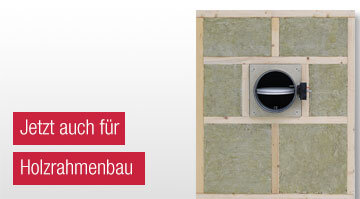- Proven fire dampers also CE-certified for timber frame constructions and timber beam ceilings
- High fire resistance period even in timber constructions with very low thicknesses
- No complex panelling of the reveal necessary
- Optimum prefabrication options in timber panel construction
The proven fire dampers for cross-laminated timber are now also CE-certified for use in timber frame construction and in timber beam ceilings. The maintenance-free FK90 and FR90 fire dampers have been tested in particularly thin walls and ceilings and can therefore be used in these almost without restriction. At the same time, system builders benefit from the tried and tested fastening methods for dry installation, which enable a rapid workflow on the construction site. For example, an installation subframe is available for mounting the shut-off devices, which means that the usual, time-consuming panelling of the reveal in the wooden construction can be dispensed with. Thanks to the extended application possibilities of the products, a suitable solution is now available for every type of wood construction.
With the fire dampers, it is possible to equip much thinner timber frame walls and timber beam ceilings with fire protection than with previous solutions. This provides considerably more flexibility in the planning and realisation of construction projects. As part of the comprehensive fire tests, the barriers were used in walls as thin as 85 mm and ceilings as thin as 100 mm. The constructions fully complied with the requirements for the fire resistance period. Accordingly, depending on the wall thickness and installation type, all required classifications from EI 30 S to EI 90 S were achieved.
With the help of the associated installation subframe, the fire dampers can also be quickly and easily installed in timber frame walls and timber beam ceilings. Up to a maximum wall thickness of 150 mm, it is not necessary to completely cover the reveal of the installation opening with plasterboard before installing the fire damper. This significantly reduces the time and labour required by the drywall installer and does not incur any additional costs for the building owner. Similarly, when installing in wooden beam ceilings, there is no need to pour a complex concrete surround around the shut-off device, meaning that no structural problems can arise.
The use of the installation subframe in timber panel construction, where the wall elements are prefabricated in the factory, proves to be particularly useful. In this way, the planner responsible and the manufacturer of the timber panel constructions can plan and realise the installation openings for the fire damper precisely. The installation on site of the fire damper in the frame is correspondingly simple. In conjunction with the environmental product declarations for the products, this fulfils all the requirements for their sustainable and efficient use for the benefit of all those involved in the construction - both in new builds and renovations.
